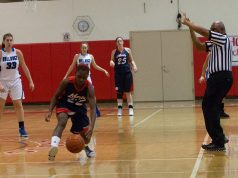R ecently, the NFHS Basketball Rules Committee approved a rule change to add a coach/bench personnel conduct warning (4-48). The committee’s goal was to provide a formal written warning for coaches and bench personnel that sent a message that corrective action needed to be taken for sportsmanship issues deemed minor in nature but that, if not corrected, could lead to a technical foul.
The committee reviewed information gathered by the Minnesota State High School League (MSHSL), which tested the system, prior to making its decision. The MSHSL sent out a postseason survey in 2017 to coaches and officials to judge how the bench warning rule went over. Jason Nickleby, coordinator of officials for the MSHSL, added that an informal survey of officials at that year’s state tournament showed the efficacy of the warning.
“We asked them how many had used the warning, and almost everybody in the room raised their hands,” Nickleby said. “Then we asked how many gave a technical foul after giving the warning, and almost every hand went down.
“The feedback we received was extremely positive. It provided another tool to get people to settle down without a penalty. It told everyone that we’d reached the point where you just need to coach and we need to officiate.”
Officials stop play to issue the warning, which is recorded in the scorebook by the scorer and reported to the head coach. Any continued misconduct by bench personnel would result in a technical foul being called on the offender.
It is suggested play should not be stopped to negatively impact the opponent while on offense — especially if an imminent scoring opportunity is present — but that the warning be withheld until the offending team has secured possession or play has stopped.
The rule change mirrored one made in baseball in 2016 to add an official written warning for coaches prior to taking the step either to restrict them to their bench/dugout or ejecting them from a game.
In both basketball and baseball, if the official deems an offense to be major, no written warning is needed prior to issuing a technical foul or restricting/ejecting the offending coach.
“State association staff and committee members witnessed a reluctance on the part of officials to call technical fouls when unsporting behavior occurred on the bench,” said Theresia Wynns, NFHS director of sports and officials, and staff liaison to the rules committee. “The thought behind the rule is to take care of the misbehavior on the bench by giving the warning and putting the coach, bench personnel and assistant coaches on notice that the officials are aware of the behavior and will not tolerate it.”
Twelve months later, coaches and officials agree it’s too early to assess whether the new rule is having its intended effect of improving sportsmanship issues but having the tool available is valuable for officials to address bench decorum.
Wynns said the NFHS had yet to receive feedback from the states regarding implementation of the rule.
Steve Bulen, Oregon state rules interpreter and commissioner of the Salem Basketball Officials Association, said the feedback he has received from the state’s officials has been mostly positive.
The warning is another tool for basketball officials
“It puts another tool in their bag,” Bulen said. “We have had about the same number of ejections in my association as we usually do. It will be interesting to compare numbers from around the state.”
Nalin Sood, longtime boys’ basketball coach at Mountlake Terrace (Wash.) High School and executive director of the Washington Interscholastic Basketball Coaches Association, said he had not seen the warning issued often in games he coached or observed. However, when it was used, it had the intended effect.
“It defused what could have warranted technicals,” Sood said. “But I would like to see it used more often. The goal behind this is increasing and promoting sportsmanship. There were too many times that I saw coaches pushing the limits toward officials, and the reason that the NFHS implemented this rule was to give a clear warning that better behavior is expected.
“Officials need to use this warning more often. The way to make it more effective is to use it more.”
Bulen added that another issue during the first year of the rule’s implementation has been inconsistent application by officials.
As the NFHS pointed out when the rule change was first announced, “judgment must be used by officials to determine the severity of the act or behavior. Different variations are going to exist for the level of disrespectfully addressing an official, attempting to influence an official’s decision, objecting to a decision by using gestures or inciting crowd reactions.”
The NFHS casebook provides this example for handling behavior that may warrant an official written warning instead of just a verbal warning: “Following a goal by A1, the head coach of B confronts the center official with language that is considered to be (a) profane and violent; (b) argumentative; (c) questioning.”
The penalties for each progress from a technical foul for (a) to a written warning for (b) and just an informal verbal warning for (c), but every official has varying levels of tolerance. What for one is argumentative may just be questioning to another, and a third may find it crossed the line into major territory.
“The only negative I’ve heard was from a coach that received a T and wasn’t warned,” Bulen said. “He felt that he had been warned in the past and that we were being inconsistent. Officials need to continue to talk about what behaviors should be warned and what behaviors are an automatic T. We will never all be in exactly the same place, but we can get closer.”
For now, Wynns said, how the bench conduct warning is to be utilized will be left to the discretion of each official.
“It is not mandatory that the warning be used,” she said. “Officials have made decisions on the use of the warning based on the temperament of the game they are working. If the act is such that the official does not feel it deserves a tech, the tool can be used to take care of the act and send a message to the coach to get his or her bench in order.”
What's Your Call? Leave a Comment:
Note: This article is archival in nature. Rules, interpretations, mechanics, philosophies and other information may or may not be correct for the current year.
This article is the copyright of ©Referee Enterprises, Inc., and may not be republished in whole or in part online, in print or in any capacity without expressed written permission from Referee. The article is made available for educational use by individuals.



















